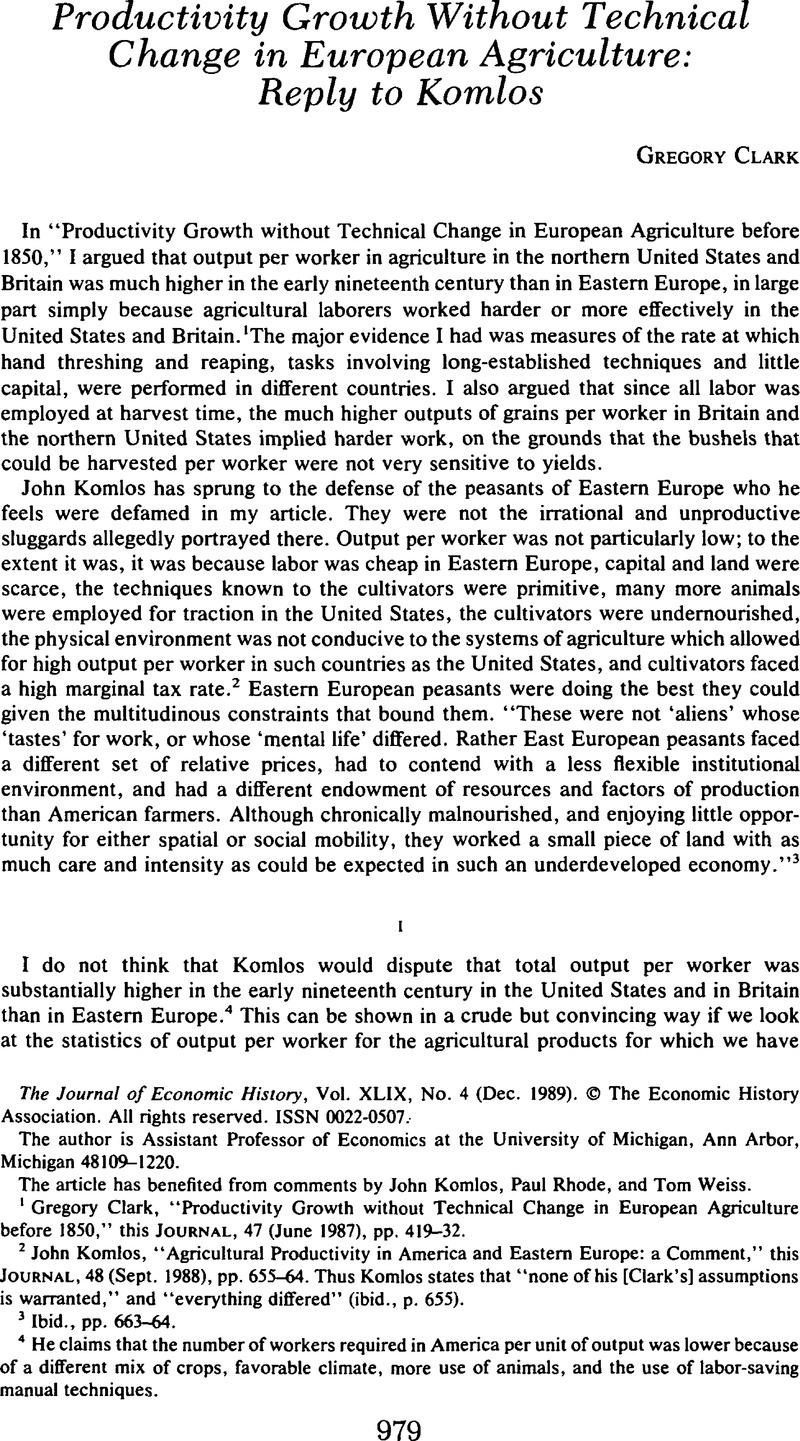Article contents
Productivity Growth Without Technical Change in European Agriculture: Reply to Komlos
Published online by Cambridge University Press: 03 March 2009
Abstract

- Type
- Notes and Discussion
- Information
- Copyright
- Copyright © The Economic History Association 1989
References
1 Clark, Gregory, “Productivity Growth without Technical Change in European Agriculture before 1850,” this JOURNAL, 47 (06 1987), pp. 419–32Google Scholar
2 Komlos, John, “Agricultural Productivity in America and Eastern Europe: a Comment,” this JOURNAL, 48 (09. 1988), pp. 655–64. Thus Komlos states that “none of his [Clark's] assumptions is warranted,” and “everything differed”Google Scholar (Ibid., p. 655).
3 Ibid., pp. 663–64.
4 He claims that the number of workers required in America per unit of output was lower because of a different mix of crops, favorable climate, more use of animals, and the use of labor-saving manual techniques.Google Scholar
5 In the index of net output per worker I assume all the maize is consumed by farm animals, and that net output of oats is gross output times the fraction of the population not in agriculture. If we assume alternatively that all oats are consumed by farmhorses, there is little effect on the index of net output per worker.Google Scholar
6 Mulhall, for example, assumes that the average cattle carcase in Britain in the late nineteenth century yielded 600 pounds of beef, compared to 500 pounds in Russia, Germany, and Austria-Hungary. Mulhall, Michael, Dictionary of Statistics (London, 1892), pp. 15, 23–27.Google Scholar
7 In practice threshers tended to earn more than the day wage, but there is no reason to expect that this differential varied from country to country.Google Scholar
8 Komlos, “Agricultural Productivity in America and Eastern Europe,” p. 661.Google Scholar
9 This implies that the errors of observation are proportional to the size of w and p, which is reasonable.Google Scholar
10 This is because ln(X) = In(x) + ε - τ, and ln(Z) = ln(z) + ε, so that ![]() and cov(lnX, InZ) = cov(Inx, Inz) + σ2e.Google Scholar
and cov(lnX, InZ) = cov(Inx, Inz) + σ2e.Google Scholar
11 When the wage measured is higher than the true wage, the threshing rate calculated, W/T, will be also too high. Thus high wages and high threshing rates will spuriously appear connected.Google Scholar
12 Komlos's only evidence that American workers were using machines for winnowing, and were able to thresh substantially more quickly because of this, is the statement of Rogin, “The total operation may also have been somewhat facilitated by the use of the fanning mill.” Rogin, Leo, The Introduction of Farm Labor in Its Relation to the Productivity of Labor in the Agriculture of the United States during the Nineteenth Century (Berkeley, 1931), p. 179.Google Scholar
13 Rogers, J. P. Thorold, A History of Agriculture and Prices in England (Oxford, 1866), vol. 2, pp. 274–334.Google Scholar
14 Jacob, William, Tracts Relating to the Corn Trade and Corn Laws: Including the Second Report (London, 1828), p. 18.Google Scholar
15 Komlos, “Agricultural Productivity in America and Eastern Europe,” p. 657.Google Scholar
16 Clark, “Productivity Growth without Technical Change,” table 2.Google Scholar
17 Yields of grain per acre complicate matters, but I argued that the number of bushels harvested per worker should not increase very much when yields per acre increased, so that the total number of bushels harvested would be a good indicator of labor intensity in agriculture. See Clark, “Productivity Growth without Technical Change.”Google Scholar
18 Mitchell, B. R., European Historical Statistics, 1750–1970 (2nd edn., New York, 1981), pp. 242, 245.Google Scholar
19 Komlos, “Agricultural Productivity in America and Eastern Europe,” pp. 655–56.Google Scholar
20 It does not matter to the argument that follows what the precise value of β is.Google Scholar
21 Mitchell, B. R., European Historical Statistics, pp. 289–322.Google ScholarMulhall, Dictionary of Statistics, pp. 6–46.Google Scholar
22 I take the relative efficiencies of labor to be those implied by the elasticity of substitution between real wages and the threshing rate being 0.15. See Table 4.Google Scholar
23 Komlos, “Agricultural Productivity in America and Eastern Europe,” p. 657.Google Scholar
24 Komlos argues that since Americans consumed about a thousand calories more per day than their counterparts, nutrition may have been an important constraint in Eastern Europe. But the direction of influence is not clear. The harder workers work the greater their calorie demands will be. Greater consumption of calories in America may thus be merely a consequence of greater efforts, and not a cause.Google Scholar
- 5
- Cited by




